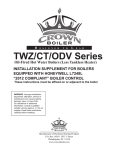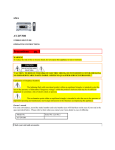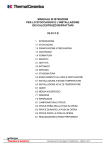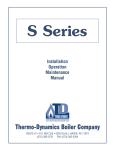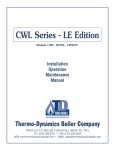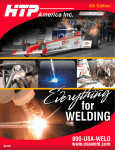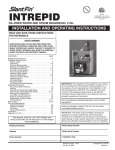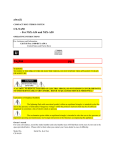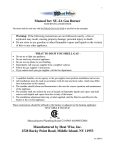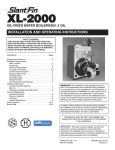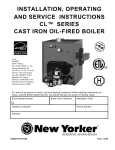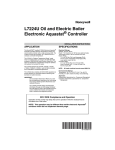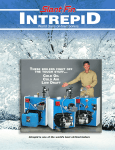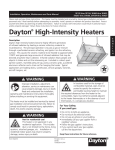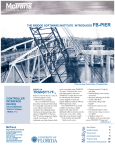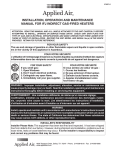Download CWL- GS Manual - Thermo
Transcript
CWL-GS Series Models CWL GS, CWL GS DV, NCWL GS, NCWL GS DV Gas Fired Packaged Boiler Installation Operation Maintenance Manual www.thermodynamicsboiler.com Thermo-Dynamics Boiler Company ROUTE 61 • P.O. BOX 325 • SCHUYLKILL HAVEN, PA 17972 TEL (570) 385-0731 • FAX (570) 385-5304 WEB www.thermodynamicsboiler.com • EMAIL [email protected] FOR YOUR SAFETY READ BEFORE OPERATING WARNING: If you do not follow these instructions exactly, a fire or explosion may result causing property damage, personal injury or loss of life A. This appliance does not have a pilot. It is equipped with an ignition device which automatically lights the burner. Do not try to light the burner by hand. *If you cannot reach your gas supplier, call the fire department. C. Use only your hand to push in or turn the gas control knob. Never use tools. If the knob will not push in or turn by hand, don’t try to repair it, call a qualified service technician. Force or attempted repair may result in a fire or explosion. B. BEFORE OPERATING smell all around the appliance area for gas. Be sure to smell next to the floor because some gas is heavier than air and will settle to the floor. WHAT TO DO IF YOU SMELL GAS *Do not try to light any appliance. *Do not touch any electric switch; do not use any phone in the building. *Immediately call your gas supplier from a neighbors phone. Follow the gas supplier’s instructions. D. Do not use this appliance if any part has been under water. Immediately call a qualified service technician to inspect the appliance and to replace any part of the control system and any gas control which has been under water. OPERATING INSTRUCTIONS 1. STOP! Read the safety information above on this label. 2. Set the thermostat to lowest setting. 3. Turn off all electric power to the appliance. 4. This device is equipped with an ignition device which automatically lights the burner. Do not try to light the burner by hand. 5. If the gas control knob is not in the “OFF” position, turn the knob clockwise to ‘OFF”. 6. Wait five (5) minutes to clear out any gas. Then smell for gas, including near the floor. If you smell gas, STOP! Follow “B” in the safety information above on this label. If you do not smell gas, go to the next step. 7. Turn gas control knob counterclockwise to “ON”. 8. Turn on all electric power to the appliance. 9. Set thermostat to the desired setting. 10. If the appliance will not operate, follow the instructions “To Turn Off Gas To Appliance” and call your service technician or gas supplier. TO TURN OFF GAS TO APPLIANCE 1. Set the thermostat to lowest setting 2. Turn off all electric power to the appliance if service is to be performed. 3. To turn off gas to appliance, turn the gas control knob clockwise to “OFF”. i Contents Safety Instructions i Service Policy 1 Component Arrangement 3 Installation 3 Operation 12 Maintenance 14 Trouble Shooting 16 Parts List 21 Product Features • ASME Coded Boiler Registered with National Board • Fully Insulated Heat Exchanger with Powder-Coated Cabinet • Packaged with Standard Five Gallon per Minute Tankless Coil For Domestic Hot Water (CWL Models Only) • NCWL Model Available Without Tankless Coil • Equipped with Triple Aquastat, Circulator, and Temperature/Altitude Gauge (CWL Models Only) • Equipped with Cold Start Aquastat, Circulator, and Temperature/Altitude Gauge (NCWL Models Only) • Additional Orifices Provided • Lifetime Limited Warranty • Available as Direct Vent ii Service Policy Congratulations on the purchase of your boiler. At Thermo-Dynamics Boiler Company we pride ourselves on the design and construction of our product. Our intent is to furnish you with a high quality appliance that will provide you and your family with years of trouble free service. In order to maintain peak performance of your boiler, it is recommended that the burner/boiler be serviced annually, preferably prior to the onset of the winter heating season. Servicing of your appliance must be performed by a qualified heating technician. You should utilize a qualified heating technician familiar with your installation to manage your heater and perform periodic maintenance. Proper care and maintenance of your boiler will allow you to enjoy the benefits of your new purchase as well as extend its long useful life. In the event that your serviceman encounters difficulty with the boiler, he/she shall contact the distributor from which the product was purchased. The distributor, in turn, will contact the Thermo-Dynamics sales representative for your area. By adhering to this protocol, Thermo-Dynamics will provide you with responsive and unparalleled service. We realize the importance of what our product means to you and your family and our goal is to get your unit up and running as quickly as possible. Thank you for purchasing the Thermo-Dynamics boiler. Again, it is our intent to provide you with a high quality trouble free product that will be part of your family for many years to come. Please consider Thermo-Dynamics Boiler Company in the future for all of your home heating needs. 1 IMPORTANT l Read carefully and consult drawings before beginning work. l The CWL-GS is factory assembled and packaged. Check shipping list as the unit and accompanying cartons are unpacked. Report shortages or damage to the delivering carrier immediately. l Safe lighting and other performance criteria were met with the gas manifold and control assembly provided on the boiler when the boiler underwent tests as specified in Gas Fired Low-Pressure Steam and Hot Water Boilers ANSI Z21.13. l The instructions, drawings, and data included in this manual are only guidelines. The equipment shall be installed in accordance with the installation requirements of the authority having jurisdiction or in the absence of such requirements to the current edition of the National Fuel Gas Code ANSI Z223.1. (Available from the American Gas Association, Pleasant Valley Road, Cleveland, Ohio 44134) l When required by the authority having jurisdiction, the installation must conform to the American Society of Mechanical Engineers Safety Code for Control and Safety Devices for Automatically Fired Boilers, No. CSD-1. l This Instruction Manual shall be kept near the boiler for future reference. ! WARNING: THIS PRODUCT MUST BE INSTALLED BY A LICENSED PLUMBER OR GAS FITTER WHEN INSTALLED WITHIN THE COMMONWEALTH OF MASSACHUSETTS. IMPROPER INSTALLATION, ADJUSTMENT, ALTERATION, SERVICE OR MAINTENANCE OF THIS BOILER MAY CAUSE INJURY OR PROPERTY DAMAGE. IF YOU SMELL GAS OR SUSPECT A GAS LEAK, TURN OFF GAS AT THE MANUAL SERVICE VALVE AND EVACUATE THE HOUSE. DO NOT TRY TO LIGHT ANY APPLIANCE. DO NOT TOUCH ANY ELECTRICAL SWITCHES OR TELEPHONES IN THE BUILDING UNTIL YOU ARE SURE NO GAS REMAINS IN THE AIR. COMPLIANCE WITH ALL APPLICABLE CODES IS THE SOLE RESPONSIBILITY OF THE INSTALLER. 2 Figure 1 Component Arrangement Installation I. GENERAL CWL-GS Series hot water boilers are high quality, high efficiency gas fired vertical fire tube heating units. The installation of the unit shall be in accordance with regulations of the authorities having jurisdiction. Refer to Local installation Codes for Gas Burning Equipment, for recommended installation practice. The CWL must be installed with the factory assembled jacket intact. II. FREIGHT CLAIMS All units should be inspected for damage upon arrival. Concealed damage claims should be filed immediately against the carrier by the consignee. The carrier is responsible for taking prompt action on all claims. III. SIZING A complete heat loss calculation of the structure is necessary to choose the proper size unit. Oversizing will result in short cycling and inefficient operation. In order to insure proper sizing of the unit, domestic hot water requirements and the structure heat load must be calculated. Replacement boilers should not be sized from the firing rate of the old boiler. A DOE sponsored study indicates 65% of the heating units in U.S. homes are substantially oversized. 3 TABLE 1 – SPECIFICATIONS Model: 120 140 160 1.95 2.28 2.60 Input BTU/HR 120,000 140,000 160,000 DOE Capacity BTU/HR 100,000 115,000 130,000 Net Rate BTU/HR 87,000 100,000 113,000 Val. Cap. Lbs/HR 160 160 160 Max. W.P. PSI 30 30 30 82.6 81.1 80.5 Water Content 15 Gal. 15 Gal. 15 Gal. Coil Capacity* 5 Gal. 5 Gal. 5 Gal. A) Jacket Height 29-1/2 29-1/2 29-1/2 B) Jacket Width 21 21 21 C) Coil Supply Height 22 22 22 D) Supply Height (Hydronic) 27-1/2 27-1/2 27-1/2 E) Burner Height 7-7/8 7-7/8 7-7/8 F) Hydronic Return Height 15-1/2 15-1/2 15-1/2 5 5 5 3-1/2 3-1/2 3-1/2 I) Jacket Depth (Inc. Flange) 22 22 22 Depth Front to Rear w/Burner 34-1/2" 34-1/2" 34-1/2" Hydronic Supply Size 1-1/4 1-1/4 1-1/4 Hydronic Return Size 1-1/4 1-1/4 1-1/4 1-1/4 (2) 1-1/4 (2) 1-1/4 (2) Boiler Specifications Firing Rate CFM AFUE Boiler Dimensions G) Flue Pipe Dia. H) Washout (Alt. Return Height) Washout Size (Alt. Return) * Intermittent draw: 5 minute draw and 5 minute waiting period 4 IV. LOCATION Place the boiler on a level floor, preferably raised and as near to the chimney or venting device as possible. Allow clearances as follows in accordance with local codes and NFPA-54. (For clearances less than the listed values, consult NFPA-54 Table 6.2.3(B). MINIMUM CLEARANCE TO COMBUSTIBLE MATERIALS Sides - 0” Rear - 0” Front - 12” Chimney Connector - 18” Top - 18” for cleaning The CWL-GS zero clearance rating is attributed to its “Wet-Leg” Design. The boiler features a wall of water on all four sides as well as the area directly above the combustion chamber, thereby eliminating hazardous chamber burn-through conditions and can be placed on combustible flooring in accordance with U.L. 726. V. AIR FOR COMBUSTION AND VENTILATION The unit must be installed where provisions exist for combustion and ventilation air. Ordinarily, provisions may be furnished by the following methods. A. Utility Room or Closet In buildings of tight construction, including most modern homes, you should provide an opening, connecting to a well ventilated attic, crawl space or directly with the outdoors. The opening should have a minimum free area of 1 square inch per 1,000 Btu per hour of total input for all appliances in the enclosure and should terminate below the burner level. Boilers installed in a confined area or closet must have two ventilation openings in the closet door. Each opening should have a free area of not less than 1 square inch per 1,000 Btu of the total input for all appliances in the enclosure. One opening located near the top of the enclosure and one near the bottom. B. Basement 1. Where a boiler is installed in a full basement, infiltration is normally adequate to provide air for combustion. 2. Buildings of tight construction where the basement windows are weather stripped, one opening communicating with a well ventilated attic or with the outdoors should be provided. The opening should have a minimum free area of 1 square inch per 1,000 Btu per hour of total input for all appliances in the inclosure. C. Special Conditions Where a boiler is located in an area where the operation of exhaust fans, kitchen ventilation systems, clothes dryers, or fire places may create conditions of unsatisfactory combustion or venting, special provisions should be made for additional air for combustion, as specified by local authority. VI. BOILER PIPING The CWL-GS Series of boilers is equipped with a built in Air Scoop. This feature allows quiet air free operation of your hot water system by assuring the removal of air pockets without the use of Air Scoops (see Figure 2) to trap noisy air. 5 The 1-1/4” supply line or riser tapping in the top of the boiler extends approximately 1” below the top or waterline of the boiler, thus allowing only air-free water to enter the supply to the heating system. The air trapped in the top of the boiler must be purged through the 3/4" vent tapping by using an Automatic Float Vent, a Manual Vent or piped into a conventional expansion tank. (See Figure 2 and 4) The recommended locations of circulators, expansion tanks, etc. are illustrated in Figure 4. Relief valve discharge and drain valve piping should be piped to a safe place of discharge. All plugs and water connections should be checked for leaks upon installation and annually. VII. TANKLESS WATER HEATER PIPING The tankless heater may be connected as shown in Figure 4. A mixing valve (not supplied) may be used to reduce the water temperature at kitchen or bathroom taps. High temperature water for a dishwasher may be obtained by piping as shown. The nuts that secure the tankless coil flange should be tightened before the boiler is filled with water, after initial firing and every year during annual maintenance. DETERIORATION DUE TO COIL GASKET LEAKS SHALL VOID WARRANTY. VIII. BURNER AND CONTROLS The gas burner is factory mounted and wired on all units. The ignition safety shut-off device must be tested when the unit is in operation. To do this turn gas supply off. Set the thermostat or controller above room temperature to call for heat. Watch for the igniter to heat up. Determine the length of time the gas valve stays open. Use a volt meter to verify voltage present at the gas valve. The length of time that power is applied to the gas valve should not exceed 4.0 seconds. To relight, see lighting and shut-down instructions. A. Primary Control - Honeywell S89F The CWL-GS Series Boiler is equipped with a Honeywell S89F Controller. The Controller is a 24 vac micro processor based control with electronic ignition and a combustion blower relay. The controller uses full time flame sensing to continually monitor flame quality with a minimum current of 0.7 microamps. In addition the controller is set for a 34 second pre purge. In the event of a flame failure, the control shall try for ignition 3 times before going into lockout. Recovery from lockout requires a manual reset by adjusting the thermostat. Alternatively, the 24 vac power supply may be disconnected for a period of 5 seconds in order to reset the control. CONTROL OPERATION When a call for heat is received from the thermostat supplying 24 volts to TH/W, the control will check the pressure switch for normally open contacts. The combustion blower is then energized and once the pressure switch contacts close, an optional prepurge delay begins and the electronic ignitor is activated. Following the ignitor heat-up period the gas valve is energized for the trial for ignition period. When flame is detected during the trial for ignition, the ignitor is de-energized immediately and the gas valve and combustion blower remains energized. The thermostat, pressure switch, and main burner flame are constantly monitored to assure the system continues to operate properly. When the thermostat is satisfied and the demand for heat ends, the main valve is de-energized immediately, the control senses the loss of flame signal and initiates an optional post-purge period before de-energizing the combustion blower. B. Aquastat Relay L7224 (For CWL Models Only) This control is installed on the middle of the domestic coil. These immersion type controls are used with forced hydronic heating systems which include domestic water service. This model provides high limits, low limits for maintaining minimum boiler water temperature and circulator controls. This control can also be used for multizone control by using a separate circulator and an R845 relay for each zone. (See Figure 6) The primary control is factory wired to the aquastat relay. These controls working as a system will pre- 6 vent the circulator operation if the water temperature is below a predetermined low level. Likewise, if the water level reaches a predetermined high limit of 205°F, the burner will automatically shut off. C. Aquastat Relay L7248 (For NCWL Models Only) This control is installed on the top center of the boiler. These immersion type controls are used with forced hydronic heating systems which include domestic water service. This model provides high limits for maintaining maximum boiler water temperature and circulator controls. This control can also be used for multizone control by using a separate circulator and an R845 relay for each zone. (See Figure 6) The primary control is factory wired to the aquastat relay. These controls working as a system will prevent the circulator operation if the water temperature is below a predetermined low level. Likewise, if the water level reaches a predetermined high limit of 205°F, the burner will automatically shut off. IX. SEQUENCE OF OPERATION Forced Circulation Hot Water System with Tankless Heater When room temperature falls below the thermostat setting, the thermostat calls for heat starting the burner and circulating pump. The burner and pump continue to operate until room heating requirements are satisfied (thermostat setting is reached), or until boiler water temperature reaches high limit control temperature setting. If the boiler high limit is reached the burner will shut off with the circulator continuing to operate until the room heating requirements are satisfied. If the thermostat continues to call for heat after the boiler temperature falls below the high limit setting the burner will restart. The boiler water temperature is normally maintained at 180°F around the tankless coil by the operating control so that an abundance of hot water is available. If the boiler water temperature should fall below the operating control setting (180-F), the burner will be started again by that control (and the circulating pump will be prevented from operating) until the operating control setting is satisfied. X. GAS PIPING Gas supply piping is to be sized and installed properly in order to provide a supply of gas sufficient to meet the maximum demand, with minimal loss of pressure between the meter and the boiler. Consult the following table for proper gas pipe sizing. The capacity of pipe in cubic feet per hour for different diameters and lengths, with a pressure drop of 0.3 inches and a specific gravity of 0.60 is shown. No allowance for an ordinary number of fittings is required. Table 3 Pipe Capacities PIPE LENGTH (FEET) 3/4" PIPE (Cu. Ft./Hr.) 1" PIPE (Cu. Ft./Hr.) 10 278 520 20 190 350 30 152 285 40 130 245 50 115 215 60 105 195 Multipliers to be used with table 1 when the specific gravity of the gas is other than 0.60 Specific Gravity 0.50 0.55 0.60 0.65 0.70 Multiplier 1.10 1.04 1.00 0.962 0.926 Locate a drop pipe adjacent to, but not in front of, the boiler. Locate a tee in the drop pipe at the same elevation as the gas inlet connection to the boiler. Extend the drop cap as shown in Figure 3 to form a sediment trap. 7 Figure 3 Gas Piping The boiler is equipped with a combination gas control. Install a ground joint union ahead of the gas control assembly to permit servicing of the control. SHUT OFF BALL VALVE See Figure 3. Install an additional shut-off valve when a combination gas control is used. See Figure 3 for the suggested location. ! NOTE: WHEN INSTALLING THE BOILER, MAKE SURE A PIPE COMPOUND RESISTANT TO THE ACTION OF LIQUEFIED PETROLEUM IS USED. Check piping for leaks. Always check leaks with a water and soap solution, or equal. DO NOT USE A FLAME FOR CHECKING GAS LEAKS. The boiler and its individual shut-off valve must be disconnected from the gas supply piping during any pressure testing of that piping at test pressures in excess of 0.5 PSIG, or 14 inches water column. The boiler must be isolated from the gas supply piping by closing its individual manual shut-off valve during pressure testing of the gas supply piping system at test pressures equal to or less than 0.5 PSIG. CWL-GS Boiler Piping Figure 4 TEMPERING VALVE DOMESTIC WATER RELIEF VALVE * Venting - Refer to Section VI BOILER PIPING ** Relief Valve discharge and drain valve piping should be piped to a safe place of discharge. 8 XI. FLUE SYSTEM CHIMNEY VENT MODELS A. Draft In order to ensure positive pressure over the fire (see specification sheet) and superior boiler performance, the draft in the flue pipe should be set to -0.02. In the event that the pressure is not at the set point, a draft regulator or draft booster may be used to correct for condition. Any draft control used in the venting system must be of listed type and installed according to local building codes and NFPA-54. B. Venting System 1. Use only an approved venting system. 2. Flue or vent connector must be the same size or larger than the outlet at the unit, and must be inserted into but not beyond the inside wall of the chimney flue. 3. The horizontal length of a chimney connector should not exceed 10 ft. unless a draft booster is used. The connector should be pitched at least 1/4” to the foot toward the unit. C. Roof Clearances The chimney flue should extend at least 3 ft. above the highest point at which the chimney comes in contact with the roof, and no less than 2 ft. above the highest roof surface or structure within 10 ft. horizontally of the chimney. DIRECT VENT MODELS Install the TV-175 Combination Vent Hood by cutting a 7-1/16" by 7-1/16" opening through an exterior wall. Ensure that the location of the hood is 12" above ground and 3' from any opening. The location must also be in area with sufficient air flow (alcoves and other obstructions such as shrubbery tend to starve the burner for air). Please see following schematic. Flash off the opening for the TV-175 Combination Vent Hood. Place additional insulation between the sides of the hood and the exterior wall to seal the opening. Connect the air intake and flue from the boiler to the combination vent system (kits are available in 10', 15' and 20' lengths). The 4" duct is for the air intake and the 5" AL 29-4C is for the exhaust. Connect the joints for the exhaust venting by using a silicon Sealant and tightening the attached cable clamps. Figure: Terminals of Direct Venting Systems (taken from NFPA-54 National Fuel Gas Code). 9 10 L7224A,C; L7248A,C,L OIL ELECTRONIC AQUASTAT® CONTROLLERS Fig. 6. L7224A,C multizone system with circulator connections. Fig. 6. L7224A,C multizone system with circulator connections and EnviraCOM™ thermostat. Fig. 6A. L7248 External Low Limit connections. Fig. 6A. L7248 multizone system with circulator connections. Figure 6. Honeywell Electrical Schematics for L7224 and L7248 Controls. D. Install a U.L. listed vent cap where the possibility of a downdraft exists, especially when located on a hillside or in a wooded area. XII. WIRING The internal wiring on package units is completed at the factory. All external wiring must be in accordance with local codes and regulations. Refer to wiring diagram for electrical connections. (Fig. 5 or 6) Field connections should be protected with a 15 amp fuse. Install a separate fuse disconnect switch near the unit so power can be shut off for servicing. Thermostat should be located centrally within the zone to be heated. Zone valves should be installed on return lines and wired per manufacturer’s specifications. 11 Operation I. START UP A. Make sure service switch to boiler is off. B. Make sure boiler has been filled with water until entire system has been purged and desired pressure obtained. C. Make sure all manual shut off valves in the gas line are open. D. Set operating controls at 180°F. E. Check to make sure that limit switch is set at 205°F. F. Check burner settings as shown in Table 1. Adjust as required. G. Bleed off any air in the gas line by attaching a 1/4 NPT nipple and stop-cock to the inlet side of the Honeywell VR8205A 2008 gas valve. Once a faint smell of gas is noticeable at the fitting, immediately shut off the valve. Allow the gas to disipate for a period of 5 minutes prior to proceeding to the next step. H. Apply 120 vac power to the aquastat control. Set thermostat above room temperature to call for heat. The control will perform a self check routine which consists of full flame sensing. Since the system calls for heat (step D), the burner will proceed with a 34 second prepurge and then attempt to fire. The burner will attempt to fire 3 times before going into lockout. ) II. START UP ADJUSTMENTS A. Equipment Required 1. CO/CO2 Analyzer 2. Draft Regulator 3. Manometer (Reads in W.C.) 4. Stack Thermometer B. Adjustment to Gas Pressure Regulator The manifold pressure should be set to: 120 140 160 Nat. Gas LP Nat. Gas LP Nat. Gas LP 3.5" 2.3" 3.5" 2.3" 3.5" 2.3" To adjust gas pressure, turn the adjusting screw of the gas pressure regulator out (counterclockwise) to decrease the pressure. Turn in (clockwise) to increase the pressure. Refer to control specification sheet supplied with the boiler for location of the gas pressure regulator. The final manifold pressure should not be more than plus or minus 0.2" water column from the specified pressure. Major changes to the gas flow should be made by changing the drill size of the burner orifice. C. Adjustments to the Burner Allow the burner to operate for at least 15 minutes and then make the following adjustments: (1) Sampling Hole - Punch a 1/4” hole in the flue pipe between the flue box and the draft regulator. Test readings should be taken at this point or inspection port. (See page 13) (2) Draft - Take a draft reading from the inspection port above the burner, directly in the combustion chamber. This reading must be taken DURING combustion. This “Over-the-Fire” reading must be POSITIVE pressure. (Refer to Table 1) (3) Combustion Set-up - Air Band and Head settings shown in the table are approximate. The Burner MUST be set-up and adjusted during actual field installed conditions. 12 HEAD AND AIR ADJUSTMENT To access the head and air adjustment, remove the plastic cover from the rear of the housing, using the supplied 4 mm allen kay. The left dial is the head adjustment dial; the right dial is the air adjustment dial. These dials can spin 360° 22 times for the head and 32 times for the air. Using the same 4 mm allen kay, turn the numbered dials to the appropriate head setting. These recommended settings are only approximate settings. Actual field conditions will vary and require a certified technician with a combustion analyzer to adjust the burner. OEM settings may differ. When to adjust the Air The air shutter is a mechanical shutter. Do NOT over crank the air shutter. You must use an analyzer to measure the CO2 (Carbon Dioxide). General rule: if the CO2 is too low, then close the air shutter. If the CO2 is too high, then open the air shutter. Note: Do NOT set the CO2 higher than 9.8% for Natural Gas or 11.5% for LP Gas. If the CO (Carbon Monoxide) is above 100 ppm, there is either too much air or too little air. Check the CO2 Level and adjust the burner. When to adjust the Head The retention head is 1/8" inside the tube when the marking reads ‘22’. There is a full 1/2" movement for the retention disk to move backward (to increase secondary air) or forwards (to decrease secondary air). NOTE: the head physically moves within the blast tube. Do not over crank the head dial. This movement can also be used to compensate for back pressure in the combustion area, up to 0.3" W.C. Caution: If this is the case, the flange and the combustion chamber should be completely sealed. This pressure firing decreases as the firing rate increases. See Graph 1. Note: the burner should be adjusted while it is firing. Combustion Analysis You can also take flue gas sampling from the sight fitting/sampling port above the burner. If using the sampling port, do not insert the probe into the combustion area too far. Insert probe approximately 1/2” to 1”. Excessive insertion may cause false readings. D. Check Out Procedure After starting the boiler, make certain all controls are working properly before leaving the boiler unattended. Check to be certain that the temperature limit control will shut off the boiler in the event of excessive temperature, by lowering the High Limit set point until the burner shuts off. Reset the High Limit to the desired temperature setting. Check main gas valve when closed to be certain there is no leakage. Check all joints for gas leakage. Use soap solution to check for leakage. Check the operation of the Ignition System safety shut off device using the following method: 1) Turn gas supply off. 2) Set thermostat above room temperature to call for heat. 3) Time the length of time gas valve stays open. The time should not exceed 4.0 seconds. III. BURNER SERVICING A. Burner Components If a replacement part is necessary, use only the part specified on the burner parts list in the burner manual. Specify the part number and description when ordering. B. Orifice To increase the firing rate, use only the orifices provided. Any attempt to “drill out” the orifice will void the warranty for the burner. C. Set Up For specific set up procedures refer to the Installer/Serviceman Decal on the boiler or to this manual. 13 Maintenance I. IMPORTANT ESCAPING GASES ARE DANGEROUS. THE ENTIRE FLUE AND VENTING SYSTEM SHOULD BE INSPECTED AT LEAST ONCE A YEAR BY A QUALIFIED SERVICEMAN. II. HEAT EXCHANGER The tubular portions of the heat exchanger should be examined annually for scale and soot accumulation. Remove scale and soot with a flexible brush and a boiler vacuum cleaner. Be careful not to damage internal refractory insulation of the chamber floor. Properly seal flue box gasketing and bolts. III. GAS BURNER A. Thoroughly brush clean the air intake screen of the burner to ensure proper air delivery. B. Properly seal the burner flange bolts. IV. LUBRICATION The blower motor is equipped with sealed bearings and therefore, does not require lubrication. V. GASKETS Tighten nuts on water coil to prevent any gasket leaks. DETERIORATION DUE TO COIL GASKET LEAKS SHALL VOID WARRANTY. VI. WIRING Check the electrical wiring for damage of frayed insulation. HOMEOWNER INFORMATION Your serviceman is: Name: Address: Phone No.: 14 A. General NEVER BURN GARBAGE OR REFUSE IN YOUR HEATING UNIT. NEVER TRY TO IGNITE GAS BY TOSSING BURNING MATERIAL INTO YOUR BOILER AND NEVER LEAVE COMBUSTIBLE MATERIAL AROUND IT. B. Combustion Air Supply Your burner requires an ample amount of clean air in order to completely and efficiently burn its fuel. If an ample supply is not available, erratic operation, noisy combustion, and fuel odors in the air may result. Remember that venting fans or a vented dryer will greatly increase the need for outside air. (See Section V, part C) C. Area Around Boiler The area around the boiler should be kept clean and free of any combustible materials, particularly oily rags and papers. The boiler should be accessible for ease of service. If burner is shut down for extended period of time, shut off manual fuel supply valve. Brush clean flue passages and vacuum clean unit. Inspect for leaks at gaskets and fittings. Follow starting procedures to restart. SERVICE INFORMATION To avoid unnecessary expense and inconvenience, the boiler and burner should be cleaned and serviced at least once a year by a qualified serviceman. If difficulty occurs, the following should be observed before calling the serviceman: A. Check to be sure that the gas line is not shutoff. B. Check to see if the thermostat setting is above room temperature C. Check to see if the service switch is in the on position. DO NOT TAMPER WITH THE UNIT OR ITS CONTROLS. 15 TROUBLE SHOOTING GUIDE TROUBLE: TOO MUCH HEAT SOURCE PROCEDURE CAUSES REMEDY CIRCULATOR CHECK TO SEE IF OPERATING CONTROL IS OPERATING PROPERLY CIRCULATOR DOES NOT STOP RUNNING REPAIR THERMOSTAT CHECK THERMOSTAT SETTINGS AND CALIBRATION THERMOSTAT SET TO HIGH RESET THERMOSTAT THERMOSTAT DEFECTIVE REPLACE THERMOSTAT THERMOSTAT OUT OF CALIBRATION RECALIBRATES FLOW VALVE DIRTY AND STUCK CLEAN FLOW VALVE FLOW VALVE DEFECTIVE REPLACE FLOW VALVE FLOW VALVE CHECK TO SEE IF FLOW VALVE IS OPERATING PROPERLY TROUBLE: HIGH NET STACK TEMPERATURES SOURCE PROCEDURE CAUSES REMEDY GAS VALVE CHECK MANIFOLD PRESSURE WITH MANOMETER OVER FIRING DUE TO INCREASED GAS PRESSURE POINT CHECK TO ENSURE ORIFICE IS INSTALLED. TURN GAS VALVE SET HEAT EXCHANGER CHECK HEAT EXCHANGER SURFACES FOR SOOT AND FOULING HEAT EXCHANGER FOULED CLEAN HEAT EXCHANGER TROUBLE: INSUFFICIENT DOMESTIC HOT WATER SOURCE PROCEDURE CAUSES REMEDY OPERATING CONTROL CHECK OPERATING CONTROL SETTING SETTING TO LOW SET OPERATING CONTROL TO 180°F COIL HEAT EXCHANGER INSPECT COILS FOR FOULED SURFACES AND/OR FLOW RESTRICTIONS FLOW RESTRICTION REMOVE RESTRICTION FOULED SURFACES ON HEAT EXCHANGER CLEAN HEAT EXCHANGER SURFACES TROUBLE: BOILING NOISE IN TOP OF BOILER SOURCE PROCEDURE CAUSES REMEDY VENTING CHECK IF SYSTEM IS PROPERLY VENTED DEFECTIVE FLOAT VENT REPLACE VENT WATERLOGGED EXPANSION TANK DRAIN TANK MANUAL VENT REQUIRES VENTING OPEN VENT IMPROPER VENTING SEE BOILER PIPING SECTION 16 TROUBLE: BURNER FIRES BUT PULSATES SOURCE PROCEDURE CAUSES REMEDY COMBUSTION AIR INSPECT INSTALLATION FOR COMBUSTION AIR PROVISIONS IMPROPER INSTALLATION PROVIDE OPENINGS THAT COMMUNICATE WITH OUTSIDE OPEN AIR BAND WIDE AND TAKE CO2 READING IMPROPER ADJUSTMENT ADJUST CO2 LEVEL-START WITH AIR BAND WIDE OPEN GAS SUPPLY BLEED GAS LINE NEW PIPING NOT PURGED OF AIR TIGHTEN ALL FITTINGS GAS PRESSURE INSTALL A MANOMETER IN THE GAS LINE. PRESSURE SHOULD READ BETWEEN 5.0 AND 11.0 W.C. LOW SUPPLY PRESSURE HAVE GAS COMPANY INCREASE INCOMING SUPPLY PRESSURE TOO MANY LINE RESTRICTIONS INCREASE OVERALL DIAMETER OF THE GAS LINE IMPROPERLY SIZED ORIFICE REPLACE WITH ORIFICE SPECIFIED IN MANUAL ORIFICE DISCONNECT GAS LINE AND INSPECT ORIFICE NO ORIFICE INSTALLED HEAT EXCHANGER RESTRICTIONS TAKE DRAFT READING OVER THE FIRE AND AT THE FLUE BOX. THE DIFFERENCE SHOULD NOT EXCEED +.04W.C. PLUGGED HEAT EXCHANGER CLEAN OUT HEAT EXCHANGER BURNER MOTOR BURNER MOTOR TRIPS ON OVERLOAD TURN OFF POWER AND ROTATE BLOWER BY HAND TO CHECK FOR EXCESSIVE DRAG LINE VOLTAGE BELOW 102V CALL UTILITY COMPANY FAULTY MOTOR REPLACE MOTOR BLOWER OVERLOADING MOTOR REPLACE BLOWER DOWN DRAFTS INSTALL VENT CAP INSUFFICIENT DRAFT INCREASE DRAFT SETTING EXCESSIVE DRAFT REDUCE DRAFT SETTINGS, INSTALL DRAFT REGULATOR IF NECESSARY DRAFT TAKE A DRAFT READING. DRAFT SHOULD BE O TO +.10 POSITIVE PRESSURE OVER FIRE. 17 TROUBLE: BURNER FIRES, BUT THEN FAILS ON SAFETY SOURCE PROCEDURE CAUSES REMEDY FLAME SENSOR CHECK CAD CELL WITH OHMMETER. IF MORE THAN 2000 OHMS, CAD CELL IS DEFECTIVE OR DIRTY FAULTY FLAME SENSOR CLEAN OR REPLACE PRIMARY CONTROL AFTER BURNER FIRES OPEN CAD CELL CIRCUIT IF FLAME LOOK GOOD, IF BURNER CONTINUES TO OPERATE FAULT IS IN PRIMARY CONTROL FAULTY PRIMARY CONTROL REPLACE PRIMARY CONTROL TROUBLE: BURNER FIRES THEN LOSES FLAME SOURCE PROCEDURE CAUSES REMEDY POOR FIRE INSPECT FOR FLAME STABILITY UNBALANCED FIRE ADJUST BURNER INSERTION DEPTH EXCESSIVE DRAFT REDUCE DRAFT SETTING INSUFFICIENT DRAFT INCREASE DRAFT TO LITTLE COMBUSTION AIR INCREASE COMBUSTION AIR COMBUSTION AIR REDUCE COMBUSTION AIR SUPPLY TOO MUCH COMBUSTION AIR CLOSE AIR BAND TO RAISE CO2 TO PROPER LEVELS EXCESSIVE DRAFT TAKE A DRAFT READING DRAFT SHOULD BE O TO +.02 POSITIVE INCORRECT DRAFT SETTING REDUCE DRAFT SETTING INSTALL SECOND DRAFT PRESSURE OVER THE FIRE REGULATOR IF NECESSARY 18 TROUBLE: INSUFFICIENT HEAT SOURCE PROCEDURE CAUSES REMEDY CIRCULATOR CHECK IF CIRCULATOR IS OPERATIONAL COUPLING WORN OR BROKEN REPLACE COUPLING PUMP BINDING REPLACE PUMP CIRCULATOR MOTOR BURNED OUT REPLACE CIRCULATOR MOTOR WIRING FROM OPERATING CONTROL DEFECTIVE REPAIR WIRING OPERATING CONTROL DEFECTIVE REPAIR OR REPLACE OPERATING CONTROL CHECK IF CIRCULATOR IS CORRECT SIZE CIRCULATOR TO SMALL REPLACE WITH PROPER CIRCULATOR CHECK VOLTAGE TO CIRCULATOR INSUFFICIENT VOLTAGE CALL UTILITY COMPANY CHECK THERMOSTAT SETTINGS SETTINGS TO LOW INCREASE SETTING CHECK THERMOSTAT LOCATION BAD LOCATION DUE TO HEAT BUILD UP MOVE THERMOSTAT TO A BETTER LOCATION CHECK THERMOSTAT LOCATION OUT OF CALIBRATION RECALIBRATES FLOW VALVE CHECK FLOW VALVE FOR STICKING IN PARTIALLY CLOSED POSITION FLOW VALVE NOT OPENING FULLY CLEAN OR REPLACE FLOW VALVE RADIATION CHECK RADIATORS FOR AIR RADIATORS AIR BOUND BLEED RADIATORS CHECK TO SEE IF RADIATORS ARE PROPERLY SIZED RADIATORS INADEQUATE INSTALL ADEQUATE RADIATION BOILER DETERMINE STRUCTURE HEAT LOAD BOILER TO SMALL ADDITIONAL HEATING CAPACITY REQUIRED TANKLESS COIL CHECK USAGE OF DOMESTIC HOT WATER DEMAND TO LARGE INSTALL FLOW REGULATOR THERMOSTAT ADDITIONAL BOILER CAPACITY REQUIRED PIPING CHECK TO SEE IF PIPING IS PROPERLY SIZED PIPING INADEQUATE INSTALL ADEQUATE PIPING HEAT EXCHANGER CHECK HEAT EXCHANGER FOR SOOT OR SCALE ACCUMULATION INSUFFICIENT HEAT TRANSFER CLEAN HEAT EXCHANGER BURNER INCREASE GAS MANIFOLD PRESSURE BY OPENING UP THE GAS VALVE DECREASE IN GAS LINE PRESSURE CHECK WITH GAS COMPANY FOR CHANGES IN SERVICE CHECK FOR LEAKS UPSTREAM OF BURNER 19 TROUBLE: BURNER DOES NOT START SOURCE PROCEDURE CAUSES REMEDY THERMOSTAT CHECK THERMOSTAT SETTINGS THERMOSTAT SET TO LOW TURN THERMOSTAT UP THERMOSTAT ON “OFF” OR “COOL” SWITCH TO HEAT OPEN THERMOSTAT WIRES REPAIR OR REPLACE WIRES LOOSE THERMOSTAT CONNECTORS TIGHTEN CONNECTIONS FAULTY THERMOSTAT REPLACE THERMOSTAT THERMOSTAT NOT LEVEL LEVEL THERMOSTAT DIRTY THERMOSTAT CONTACTS CLEAN CONTACTS CHECK BURNER MOTOR OVERLOAD SWITCH BURNER MOTOR TRIPPED ON OVERLOAD PUSH RESET BUTTON CHECK PRIMARY CONTROL SAFETY SWITCH PRIMARY TRIPPED ON SAFETY RESET SAFETY SWITCH CHECK BOILER DISCONNECT SWITCH AND MAIN DISCONNECT SWITCH SWITCH OPEN CLOSE SWITCH TRIPPED BREAKER OR BLOWN FUSE RESET BREAKER OR REPLACE FUSE LIMIT CONTROL SWITCH OPEN CHECK LIMIT SETTING JUMPER TT TERMINALS ON AQUASTAT CIRCUIT OVERLOADS POWER PRIMARY CONTROL BURNER MOTOR CHECK FOR VOLTAGE AT THE BURNER BETWEEN THE BLACK AND WHITE WIRES JUMPER TERMINALS-IF BURNER STARTS REPLACE CONTROL OPEN CIRCUIT BETWEEN LIMIT CONTROL AND DISCONNECT SWITCH REPAIR CIRCUIT LOW ONE VOLTAGE OR POWER CALL UTILITY COMPANY CHECK FOR VOLTAGE AT THE BURNER BETWEEN THE ORANGE AND WHITE WIRES. NO VOLTAGE INDICATES A FAULTY CONTROL DEFECTIVE CONTROL REPLACE CONTROL CHECK FOR VOLTAGE PUMP SEIZED BURNER MOTOR LEADS BLOWER WHEEL BINDING TURN OFF POWER TO BURNER. ROTATE BY HAND, CHECK FOR EXCESSIVE DRAG. REPLACE FUEL UNIT OR BLOWER WHEEL BURNER MOTOR DEFECTIVE REPLACE BURNER MOTOR 20 Parts List CWL-GS (Designate boiler and burner model numbers on all orders.) Item No. Part No. Description 1 542241 Heatwise SU-2A Gas Burner 2 542243 Heatwise SU-2A DV Gas Burner 3 535030 007 Circulator Pump 4 552102 Aquastat Control L7224C (on CWL GS/CWL GS DV) 5 552116 Aquastat Control L7248 (on NCWL GS/NCWL GS DV) 6 575020 Relief Valve (3/4" Male) 7 559560 Altitude Gauge 1/4" x 2-1/2" Round 8 481005 Coil Gasket (TDR) 9 530247 TDR5L Coil with Gasket-Cartoned 10 229151 Blank Coil Plate with 1/8" and 3/4" Tapping 11 190399 Baffles (CWL, 10 required) 12 190401 Flue Box (Top Vent) 13 199991 Flue Box (Rear Vent with Regulator) 14 337135 Gasket Material (25' Roll) 15 337799 Cerablanket Floor Insulation 14 337800 Ceraform Floor Board 19 x 19 542260 LP Orifice 15/64 542261 Natural Gas Orifice 19/64 21 INSTALLER/SERVICEMAN INSTALLER/SERVICEMAN Fixed Pressure and Variable Orifice Fixed Pressure and Variable Orifice Model Number CWL-GS-120 CWL-GS-140 CWL-GS-160 _________________________ Model Number CWL-GS-120 CWL-GS-140 CWL-GS-160 _________________________ Burner Type Heat Wise Heat Wise Burner Type Heat Wise Heat Wise Heat Wise Burner Model SU-2A SU-2A SU-2A _________________________ Fuel Nat. Gas Nat. Gas Nat. Gas _________________________ Orifice 15/64" 1/4" 19/64" _________________________ Max Inlet Pressure _________________________ 11" 11" 11" Min Inlet Pressure _________________________ 5" 5" 5" Manifold Pressure _________________________ 3.5" 3.5" 3.5" Head Position 11 11 11 _________________________ Air Shutter 12.50 15.00 20.75 _________________________ Draft Over Fire + 0.04" + 0.06" + 0.08" _________________________ Draft In Stack -0.02" -0.02" -0.02" _________________________ Burner Model CO2 Reading CO2 Reading 9.0% 9.0% Heat Wise SU-2A SU-2A SU-2A _________________________ Fuel LP Gas LP Gas LP Gas _________________________ Orifice 15/64" 1/4" 19/64" _________________________ Max Inlet Pressure _________________________ 11" 11" 11" Min Inlet Pressure _________________________ 4.5" 4.5" 4.5" Manifold Pressure _________________________ 2.3" 2.3" 2.3" Head Position 11 11 11 _________________________ Air Shutter 14.50 17.00 20.25 _________________________ Draft Over Fire + 0.04" + 0.06" + 0.08" _________________________ Draft In Stack -0.02" -0.02" -0.02" _________________________ 9.0% 11% 11% 11% NOTICE Above settings are approximate. Final adjustments to be made with proper test equipment. See installation/service manual for detailed information. NOTICE Above settings are approximate. Final adjustments to be made with proper test equipment. See installation/service manual for detailed information. INSTALLER/SERVICEMAN INSTALLER/SERVICEMAN CWL-GS DIRECT VENT Fixed Pressure and Variable Orifice CWL-GS DIRECT VENT Fixed Pressure and Variable Orifice Model Number Burner Type Model Number CWL-GS-120DV CWL-GS-140DV CWL-GS-160DV _________________________ Heat Wise Heat Wise Heat Wise Burner Type Burner Model SU-2A SU-2A SU-2A _________________________ Fuel Nat. Gas Nat. Gas Nat. Gas _________________________ Orifice 15/64" 1/4" 19/64" _________________________ Max Inlet Pressure _________________________ 11" 11" 11" Min Inlet Pressure _________________________ 5" 5" 5" Manifold Pressure _________________________ 3.5" 3.5" 3.5" Head Position 11 11 11 _________________________ Air Shutter 12.50 15.00 20.75 _________________________ Draft Over Fire + 0.10" + 0.14" + 0.18" _________________________ Draft In Stack -0.06" -0.08" -0.10" _________________________ Burner Model CO2 Reading CO2 Reading 9.0% 9.0% CWL-GS-120DV CWL-GS-140DV CWL-GS-160DV _________________________ Heat Wise Heat Wise Heat Wise SU-2A SU-2A SU-2A _________________________ Fuel LP Gas LP Gas LP Gas _________________________ Orifice 15/64" 1/4" 19/64" _________________________ Max Inlet Pressure _________________________ 11" 11" 11" Min Inlet Pressure _________________________ 4.5" 4.5" 4.5" Manifold Pressure _________________________ 2.3" 2.3" 2.3" Head Position 11 11 11 _________________________ Air Shutter 15.50 17.75 21.00 _________________________ Draft Over Fire + 0.10" + 0.14" + 0.18" _________________________ Draft In Stack -0.06" -0.08" -0.10" _________________________ 9.0% NOTICE Above settings are approximate. Final adjustments to be made with proper test equipment. See installation/service manual for detailed information. 11.0% 11.0% 11.0% NOTICE Above settings are approximate. Final adjustments to be made with proper test equipment. See installation/service manual for detailed information. 22 INSTALLER/SERVICEMAN INSTALLER/SERVICEMAN Fixed Pressure and Variable Orifice Fixed Pressure and Variable Orifice Model Number NCWL-GS-120 NCWL-GS-140 NCWL-GS-160 _________________________ Model Number NCWL-GS-120 NCWL-GS-140 NCWL-GS-160 _________________________ Burner Type Heat Wise Heat Wise Burner Type Heat Wise Heat Wise Heat Wise Burner Model SU-2A SU-2A SU-2A _________________________ Fuel Nat. Gas Nat. Gas Nat. Gas _________________________ Orifice 15/64" 1/4" 19/64" _________________________ Max Inlet Pressure _________________________ 11" 11" 11" Min Inlet Pressure _________________________ 5" 5" 5" Manifold Pressure _________________________ 3.5" 3.5" 3.5" Head Position 11 11 11 _________________________ Air Shutter 12.50 15.00 20.75 _________________________ Draft Over Fire + 0.04" + 0.06" + 0.08" _________________________ Draft In Stack -0.02" -0.02" -0.02" _________________________ Burner Model CO2 Reading CO2 Reading 9.0% 9.0% Heat Wise SU-2A SU-2A SU-2A _________________________ Fuel LP Gas LP Gas LP Gas _________________________ Orifice 15/64" 1/4" 19/64" _________________________ Max Inlet Pressure _________________________ 11" 11" 11" Min Inlet Pressure _________________________ 4.5" 4.5" 4.5" Manifold Pressure _________________________ 2.3" 2.3" 2.3" Head Position 11 11 11 _________________________ Air Shutter 14.50 17.00 20.25 _________________________ Draft Over Fire + 0.04" + 0.06" + 0.08" _________________________ Draft In Stack -0.02" -0.02" -0.02" _________________________ 9.0% 11% 11% 11% NOTICE Above settings are approximate. Final adjustments to be made with proper test equipment. See installation/service manual for detailed information. NOTICE Above settings are approximate. Final adjustments to be made with proper test equipment. See installation/service manual for detailed information. INSTALLER/SERVICEMAN INSTALLER/SERVICEMAN NCWL-GS DIRECT VENT Fixed Pressure and Variable Orifice NCWL-GS DIRECT VENT Fixed Pressure and Variable Orifice Model Number Burner Type Model Number NCWL-GS-120DV NCWL-GS-140DV NCWL-GS-160DV _________________________ Heat Wise Heat Wise Heat Wise Burner Type Burner Model SU-2A SU-2A SU-2A _________________________ Fuel Nat. Gas Nat. Gas Nat. Gas _________________________ Orifice 15/64" 1/4" 19/64" _________________________ Max Inlet Pressure _________________________ 11" 11" 11" Min Inlet Pressure _________________________ 5" 5" 5" Manifold Pressure _________________________ 3.5" 3.5" 3.5" Head Position 11 11 11 _________________________ Air Shutter 12.50 15.00 20.75 _________________________ Draft Over Fire + 0.10" + 0.14" + 0.18" _________________________ Draft In Stack -0.06" -0.08" -0.10" _________________________ Burner Model CO2 Reading CO2 Reading 9.0% 9.0% NCWL-GS-120DV NCWL-GS-140DV NCWL-GS-160DV _________________________ Heat Wise Heat Wise Heat Wise SU-2A SU-2A SU-2A _________________________ Fuel LP Gas LP Gas LP Gas _________________________ Orifice 15/64" 1/4" 19/64" _________________________ Max Inlet Pressure _________________________ 11" 11" 11" Min Inlet Pressure _________________________ 4.5" 4.5" 4.5" Manifold Pressure _________________________ 2.3" 2.3" 2.3" Head Position 11 11 11 _________________________ Air Shutter 15.50 17.75 21.00 _________________________ Draft Over Fire + 0.10" + 0.14" + 0.18" _________________________ Draft In Stack -0.06" -0.08" -0.10" _________________________ 9.0% NOTICE Above settings are approximate. Final adjustments to be made with proper test equipment. See installation/service manual for detailed information. 11.0% 11.0% 11.0% NOTICE Above settings are approximate. Final adjustments to be made with proper test equipment. See installation/service manual for detailed information. 23 P/N 595830 100-2/10 MET-235





























